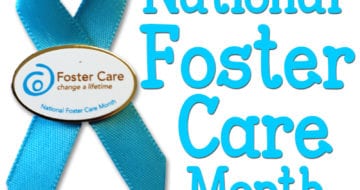
Garet Fryar, Policy Research Assistant
Most young people breathe a sigh of relief as the school year ends in a flurry of finals and summer freedom begins. Many students who complete their final year in high school or a semester in postsecondary education typically have the summer off to relax, earn some spending money at a temporary job, or participate in an internship to gain new skills. However, for youth involved with the foster care system, summer can become a time when there is significantly less stability than during the school year.
Foster care youth, transitioning to postsecondary opportunities from high school or a GED program, often face a decreased amount of adult involvement from teachers, counselors, and after school providers. once they earn their high school diploma. Young people can then easily get off course and become distracted from pursuing their education for various reasons, such as financial and permanency needs. While 84 percent of foster youth age 17-18 want to go to college, only 20 percent of foster youth who graduated from high school enroll and attend college.
Many youth become responsible for aspects of their life that were usually taken care of by others, such as housing, health care, and meals, once they turn 18 and “age out” of care. Even youth who extend their foster care through the Fostering Connections to Success and Increasing Adoptions Act of 2008 and continue to receive federal funds are frequently ill-prepared for the realities of living without their accustomed supports. Having knowledge of responsible financing and earning enough money to sustain oneself can become overwhelming for youth who did not have a responsible financial role model or were not taught financial literacy. While programs like the Jim Casey Youth Opportunities Initiative’s Opportunity Passport Financial Literacy Curriculum provide assistance for some foster care youth, many other young people often find themselves without appropriate funds. This is one of the many reasons 36 percent of youth formerly in foster care, whose outcomes were known, have reported at least one episode of homelessness by the age of 26. Homelessness then becomes a huge barrier to education success when students have to worry about where they sleep at night instead of what form they need to turn into school or what reading assignment they need to complete.
However, summer bridge programs can alleviate some of the struggles and help these young people stay on their education pathway. Bridge programs allow youth to stay connected to higher education institutions and their support services through deadline reminders, familiarity with the school, and connections with administrators and staff. For example, the Care Summer Bridge Program at Florida State University not only offers students from socio-economically disadvantaged backgrounds, including foster care, summer housing on campus, but also provides opportunities like meetings with key University faculty, staff, and administrators who will become part of the student’s support system. Options for Postsecondary Transition (OPT-in) through the Youth Policy Institute of Iowa (YPII) is a pilot program that offers weekly opportunities for foster care students in high school to assess their individual interests and aptitudes and to explore postsecondary opportunities in the Des Moines area. This summer, a cohort of around 20 young adults participated in an eight-week summer bridge program based on the Back on Track model that includes an individualized plan that identifies interests and aptitudes and connections to campus and community resources. Lastly, the TRIO Student Support Services Program funded by the U.S. Department of Education aids students in preparation for postsecondary education through grants awarded to institutions of higher education. These programs provide students with supports such as academic tutoring, assistance with financial aid programs, advice in course selection, and can help secure temporary housing during breaks for students who are homeless and/or foster youths.
For youth who have already completed a semester or two of postsecondary education, returning for the next year after a summer off also presents its challenges. Studies have found that between two and nine percent of former foster youth in college attain a bachelor’s degree. During the summer, foster youth need to secure their housing and a living wage job to ensure their stability so that they are physically and financially ready for the next school year. However, when young people find a summer opportunity that is outside their budget and/or region, the necessity for a strong, wide safety net becomes clear.
“Permanency became a front and center issue when my former foster parents blatantly told me they would not support me with making the down payment on the summer home I was going to sublet. The National Human Genome Research Institute had offered me a paid fellowship and I needed financial assistance to make the first rental payment so I could move to Bethesda, Maryland. Upon turning to my foster parents for help, they gave several reasons as to why they would not help me, including my age, and that they were making payments on their own home with their pooled income. With no other options, I opened a Credit Deposit with all of the small scholarships I had won during my senior year of high school. I had initially set these to mature in four years, but decided to withdraw to be able to pay the first month’s rent. It was then that I also signed up for my first and only credit card. Both of these decisions made it possible for me to make it in the Washington, D.C. area until I received my first paycheck.” – Maria, originally from California and recent graduate of Brown University
Some youth inform their school of their foster care background and may be involved with a foster care alumni program, such as Great Expectations at Northern Virginia Community College, Empowering my Success at the University of Michigan – Flint, and Guardian Scholars at 33 different Californian two- and four-year colleges as well as schools in Washington, Colorado, Indiana, and Massachusetts. Programs like these connect students to resources, such as housing assistance, job programs, financial aid, school and life supply-closets, counselors, and mentors, during the school year and into the summer.
Youth in transition from foster care need a combination of sustainable social capitol, permanency support, and postsecondary opportunities to help them transition to adulthood, as outlined in Creating Access to Opportunities for Youth in Transition from Foster Care. Summer months can be a challenge, instead of an opportunity, for youth to take advantage of all their extra time when they have to worry about the stability of their housing, food, and income. Joint long-term planning by youth, caseworkers, foster families, mentors, high school adults, and postsecondary institutions can provide the most opportunity to help keep youth on the track to long-term success.*
For more information on the work AYPF has recently done around transitional foster youth, please see our Creating Access to Opportunities for Youth in Transition from Foster Care page and Foster Care Youth Voice blog series.
* AYPF defines long-term success as composed of career success, civic engagement, and capacity for lifelong learning. Please see Page 14, Figure 1: AYPF Logic Model for College- and Career-Readiness and Success of the Success at Every Step: How 23 Programs Support Youth on the Path to College and Beyond.
Garet Fryar is the Policy Research Assistant at the American Youth Policy Forum.




